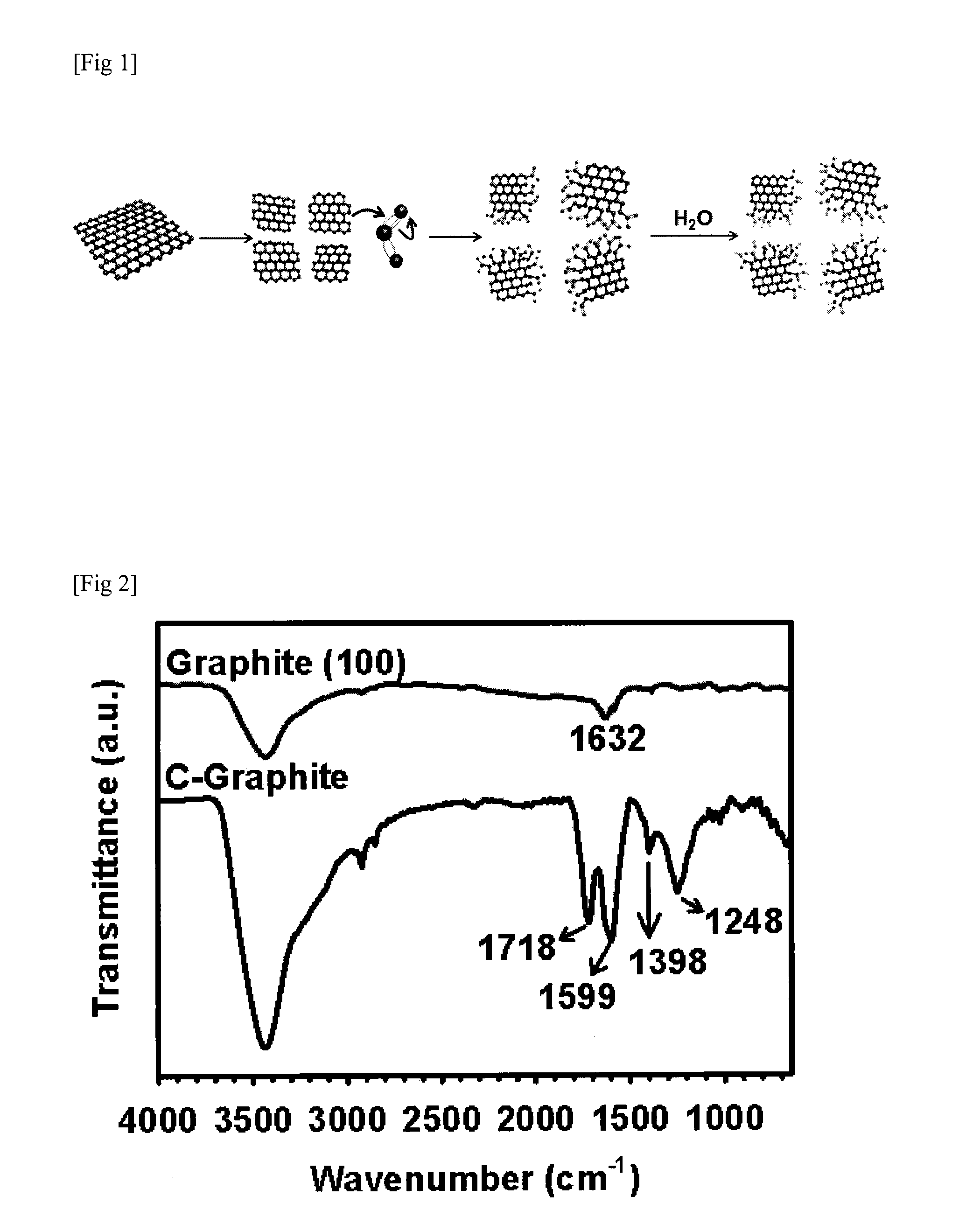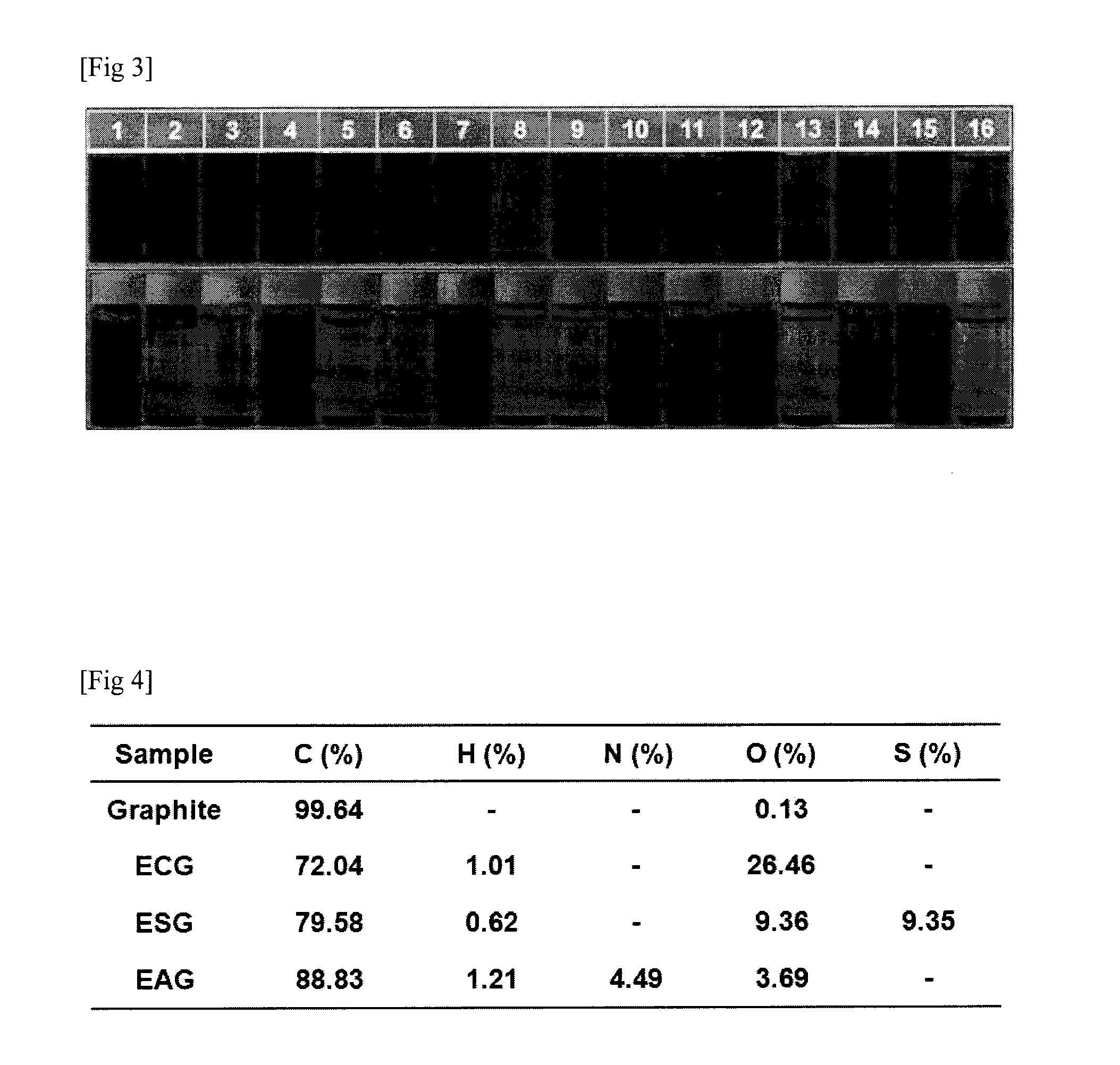Edge-functionalized graphitic material through mechanochemical process and manufacturing method thereof
a graphene and manufacturing method technology, applied in the field of mechanochemical process of edge-functionalized graphene, can solve the problems of poor economic efficiency, limited in the mass production of graphene, and extremely low final yield, and achieve the effect of superior physical and electrical characteristics, and high commercial potential
- Summary
- Abstract
- Description
- Claims
- Application Information
AI Technical Summary
Benefits of technology
Problems solved by technology
Method used
Image
Examples
embodiment 1
Manufacturing an Edge-Functionalized Graphitic Material
[0049]Graphite (99%, 100 mesh) 5 g and dry ice 100 g were placed into a pulverization metal vessel. After removing air from the pulverization vessel using a vacuum pump, a pulverization process was performed for 48 hours with about 500 rpm. After the pulverization was completely finished, metal impurities entered into the pulverized graphite material were removed by treating the pulverized material with hydrochloric acid of 1 M, followed by a lyophilization process to obtain graphitic material whose edge is functionalized with carboxyl group. Functional group was identified by elementary analyzing the obtained graphitic material (see FIG. 4). FIG. 1 depicts, as an example, steps of the method for manufacturing graphitic material functionalized at its edge with carboxyl functional group.
[0050]It can be found in FIG. 1 that a large piece of graphite was grinded to many smaller pieces of graphite where the milled graphite was charg...
embodiment 2
Manufacturing the Edge-Functionalized Graphitic Material II
[0057]Graphite (99%, 100 mesh) 5 g and sulfur trioxide (SO3) 5 ml were placed into a metal pulverization vessel. After removing air from the metal pulverization vessel using a vacuum pump, a pulverization process was performed for 48 hours with about 500 rpm. After pulverization process was completely finished, metal impurities entering the pulverized graphite material was removed by treating the pulverized material with hydrochloric acid of 1 M, followed by a lyophilization process to obtain graphitic material functionalized at the edge with —SO3H. Functional group was identified by elementary analyzing the obtained graphitic material (see FIG. 4).
embodiment 3
Manufacturing the Edge-Functionalized Graphitic Material III
[0058]Graphite (99%, 100 mesh) 5 g and ammonia gas were placed into a metal pulverization vessel. The amount of ammonia gas used in this embodiment was 250 ml taken from a full flask of 250 ml through a storage container of 8.75 atm. After removing air from the metal pulverization vessel using a vacuum pump, a pulverization process was performed for 48 hours with about 500 rpm. After the pulverization process was completely finished, metal impurities entering the pulverized material was removed by treating the pulverized material with hydrochloric acid of 1 M, followed by a lyophilization process to obtain graphitic material functionalized at the edge with —NH2. Functional group was identified by elementary analyzing the obtained graphitic material (see FIG. 4).
Description of Notations in DrawingsIn FIG. 3, notations of 1 to 16 denote the following solvents,respectively.1: H2O; 2: 1M HCl; 3: 1M NH4OH; 4: 7MNH4OH;5: 1M KOH; ...
PUM
| Property | Measurement | Unit |
|---|---|---|
| mean diameter | aaaaa | aaaaa |
| time | aaaaa | aaaaa |
| time | aaaaa | aaaaa |
Abstract
Description
Claims
Application Information
 Login to View More
Login to View More - R&D
- Intellectual Property
- Life Sciences
- Materials
- Tech Scout
- Unparalleled Data Quality
- Higher Quality Content
- 60% Fewer Hallucinations
Browse by: Latest US Patents, China's latest patents, Technical Efficacy Thesaurus, Application Domain, Technology Topic, Popular Technical Reports.
© 2025 PatSnap. All rights reserved.Legal|Privacy policy|Modern Slavery Act Transparency Statement|Sitemap|About US| Contact US: help@patsnap.com



